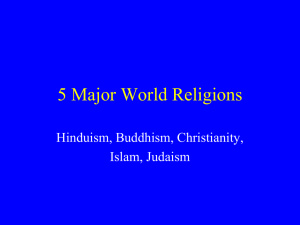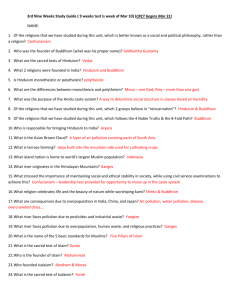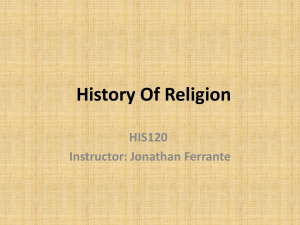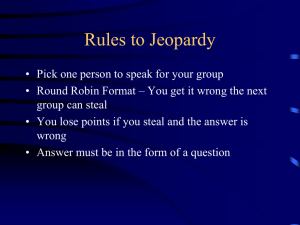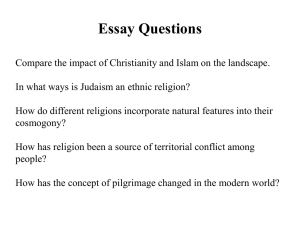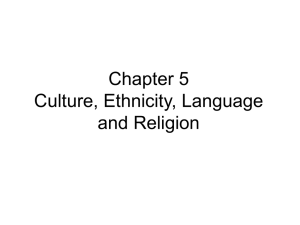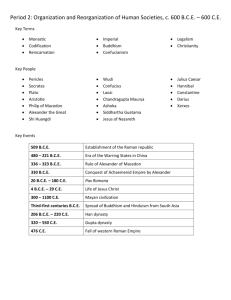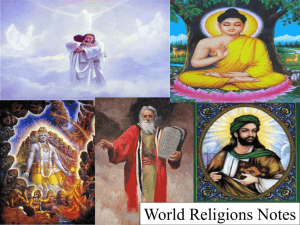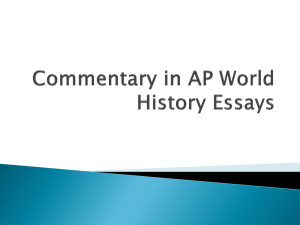AP Questions 8000-600 C.E.
advertisement
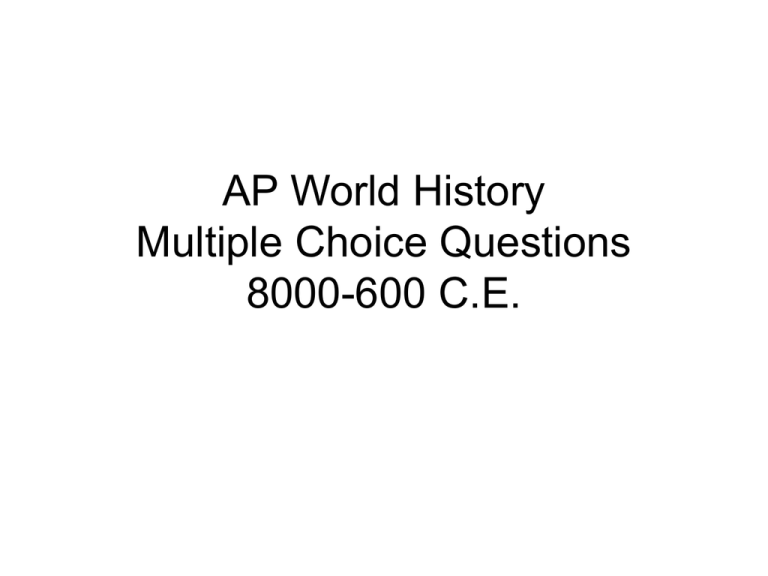
AP World History Multiple Choice Questions 8000-600 C.E. Cities differed from Neolithic villages in two principal ways. Firstly, cities were larger and more complex than Neolithic villages. Secondly, __________________________________. A. cities served the needs of their inhabitants and immediate neighbors B. cities decisively influenced the economic, political and cultural life of large regions C. cities were less advanced militarily D. cities had populations in the thousands E. cities had protective deities Answer: B Which of the following was not true of nomadic groups? A) Nomadic societies were patriarchal B) They had some social hierarchy C) Most of the themes of nomadic art centered on their animals D) Nomadic societies had little positive influence on settled peoples E) Nomadic societies engaged in peaceful trade. Answer: D What happened in western Europe after the fall of the Roman Empire was similar to what occurred in (sorry about the syntax) a) Byzantium after the end of the Eastern Empire b) China after the fall of the Han c) Japan after the end of the Tokugawa Shogunate d) The Holy Land after the unsuccessful Crusades ended e) The Andes when the Spanish ousted the Inca Answer: B A major influence on the development of western Europe was a) The movement of the Mongols b) Attila’s advance against Rome c) The spread of Islam into Spain by the Moors d) The pressure put on Germanic peoples by the movement of the Huns e) The emergence of a unified Frankish kingdom. Answer: D Which of the following statements is an accurate description of both Buddhism and Hinduism? a) The caste system was an outgrowth of Hinduism but became identified also with Buddhism. b) Neither religion placed importance on the individual’s efforts to seek release from rebirth. c) Nirvana was a major aspect of the belief system of both Buddhism and Hinduism. d) Both religions taught the importance of karma in affecting a person’s fate. e) Buddhism made use of formal rituals, but Hinduism did not. Answer: D The Mandate of Heaven governed the relationship between the ruler and the ruled in a) b) c) d) e) China Japan France Ghana Russia Answer: A Monasticism was an important aspect of which two of the following religions? a) b) c) d) e) Islam and Buddhism Buddhism and Christianity Daoism and Shintoism Hinduism and Buddhism Christianity and Hinduism Answer: B Which of the following was not a characteristic of early settled agricultural communities? a) A fertility goddess as an important element in religious worship b) The division of labor and the development of specialized skills c) Cooperative public works projects d) Equal status for men and women e) The development of immunity to contagious diseases over time. Answer: D “And what, O priests, is the noble truth of the path leading to the cessation of misery? It is…right belief, right resolve, right speech, right behavior, right occupation, right effort, right contemplation, right concentration.” These words describe a teaching of which religion? a) b) c) d) e) Judaism Hinduism Christianity Buddhism Islam Answer: D A characteristic that the Shang Chinese shared with Egyptian civilization was the a) b) c) d) e) Principle of the mandate of heaven Lack of a social hierarchy Development of a writing system Ancestor worship Development of walled settlements to defend against invaders. Answer: C Which of the following is true of both the Han Empire and the Gupta Empire? a) Both empires had long-established traditions of dynastic rule. b) Both were overrun by Germanic tribes in their declining years. c) Both empires were characterized by religious unity. d) Both saw a number of technological advances e) Both chose administrators on the basis of extensive examination systems. Answer: D The Buddhist social order included a) b) c) d) e) Strict adherence to patriarchal authority Opposition to caste systems Well-defined gender-role distinctions Emphasis on well-educated rulers Veneration for one’s ancestors Answer: B Which of the following lived after the other four? a) b) c) d) e) Confucius Siddhartha Gautama, the Buddha Jesus Christ Aristotle Laozi (Lao-Tzu) Answer: C Which of the following pairs of religions uses images to represent its deity? a) b) c) d) e) Hinduism and Christianity Judaism and Christianity Confucianism and Buddhism Islam and Christianity Islam and Hinduism Answer: A Which major language family arose as a result of migrations beginning in central Asia and spreading to Europe? a) b) c) d) e) Indo-European Romance Germanic Sino-Tibetan Semitic Answer: A Which of the great religious systems below were characterized by monotheism combined with a sacred text and a strong missionary thrust? a) b) c) d) e) Buddhism and Christianity Buddhism and Hinduism Christianity and Judaism Christianity and Islam Islam and Judaism Answer: D Which of the following is true of both the Roman Empire and the Han Empire? a) b) Both empires were heavily dependent on slave labor. Both empires were characterized by long periods of effective centralized government. c) In both empires extensive maritime trade was important. d) In both empires administrative officials were selected by an elaborate system of competitive examinations. e) Both empires were ruled by wealthy merchant elites. Answer: B All of the following were part of the Confucian social order except a) b) c) d) e) Loyalty to the ruler Filial obedience to one’s father Respect for the old Chastity by wives Chastity by husbands Answer: E Which of the following lived about one thousand years after the other four? a) b) c) d) e) Socrates Confucius Muhammad Laozi (Lao-Tzu) Siddhartha Gautama, the Buddha Answer: C Which of the following characterizes trade between the Roman Empire and India during the first two centuries C.E.? a) b) c) d) e) Rome to India Silver and gold Tools and weapons Horses Textiles Tools and weapons India to Rome Pepper Silver and gold Wheat Silver and gold Wine and olive oil Answer: A Judaism, Christianity and Islam share which of the following? a) They are polytheistic religions b) They recognize the divine nature of certain prophets. c) They revere both Mecca and Jerusalem as pilgrimage sites d) They recognize the existence of Adam and Moses. e) They share the Talmud and the Gospels as sacred texts. Answer: D The lessons of the late Han China and the late Roman empires are that the decline of a civilization, whether temporary or permanent, A. is not simply the result of attack by outside invaders. B. follows inevitably from centralized, unrepresentative government C. results from undue dependence on slavery D. results from social rebellion in which the poor attack the rich and tear down their institutions E. results from a lack of religious conviction Answer: A With the collapse in political order after the fall of the Han empire A. Confucianism became much more popular B. Christianity became one of the most important religions in China C. Daoism and Buddhism became much more popular D. Hindu thought began to have a profoundly important influence in China E. religions of every variety were persecuted and suppressed Answer: C The phrase pater familias refers to A. the patriarchal nature of the Roman family B. the prolonged period of peace and stability beginning with the reign of Augustus C. the concept of Jesus of Nazareth's relationship to his god D. the position of Jupiter as the king of the Roman gods E. the central role of the Roman emperor in running the state Answer: A The school of philosophical thought which was in the end responsible for the unification of China was A. Confucianism B. Draconianism C. Daoism D. Legalism E. Neo-Confucianism Answer: D The fundamental doctrine of Buddhism was known as the A. Second Triad B. Ahimsa Path C. Four Noble Truths D. Three Principles of the People E. Path of Reincarnation Answer: C The Greeks used the word polis to refer to A. the concept of excessive pride B. the city-state C. the notion of loyalty to the central government D. the pursuit of truth E. barbarians Answer: B The political world of the ancient Greeks A. achieved unification under Pericles B. was a history of early, long-lasting centralized government C. stabilized after the conquest by Persia D. was very similar to that of Egypt E. usually consisted of independent, autonomous city-states Answer: E The first society of Mesoamerica, which founded traditions followed by all later societies, were the A. Maya B. Olmecs C. Teotihuacan D. Mochica E. Aztecs Answer: B By 5000 B.C.E. the Mesoamericans had discovered the agricultural potential of __________, which ultimately became the staple food of the region. A. maize B. squash C. beans D. wheat E. barley Answer: A In regards to family structure, the __________ retained much more influence in China than in other lands. A. extended family B. nuclear family C. matriarchal structure D. cult of Isis E. slaves Answer: A In Hinduism the highest goal of the individual soul was A. to follow the Four Noble Truths B. to escape the cycle of birth and rebirth and enter into permanent union with Brahman C. to enter into permanent union with Indra and thus escape the cycle of permanent rebirth D. to fulfill the individual's special destiny as spelled out in the process of predestination E. to perform sati Answer: B The earliest known civilization in India was the A. Bantu B. Indo-European C. Harappan D. Sumerian E. Hindu Answer: C All of the following statements are true in relation to the Harappan society EXCEPT A. most of their houses featured private showers and toilets B. they traded extensively with the Mesopotamians C. they had social distinctions D. their writings have provided a wealth of information for historians E. they produced representational art Answer: D The Bantu originally came from around A. the Swahili area B. modern day Nigeria C. far southern Africa D. Egypt E. modern day Algeria Answer: B The Bantu probably began their migrations because of A. invasions from the Mediterranean basin B. a conscious desire for conquest C. the threat of epidemic disease D. a desire to spread their monotheistic faith E. population pressures Answer: E In which of the following societies did women enjoy the most freedom and opportunity? A. Mesopotamia B. Egypt C. Hebrews D. Assyria E. India Answer: B The first simplified alphabet, containing only 22 letters, was created by the A. Mesopotamians B. Assyrians C. Hebrews D. Phoenicians E. Babylonians Answer: D Ethical monotheism was in the tradition of the A. Mesopotamians B. Egyptians C. Assyrians D. Hebrews E. Phoenicians Answer: D The Mesopotamian style of writing was known as A. demotic B. cuneiform C. hieroglyphics D. Coptic E. alphabetic Answer: B In Mesopotamia, prisoners of war, convicted criminals, and heavily indebted individuals were the three main sources for A. slaves B. indentured servants C. dependent clients D. mercenary soldiers E. indentured priests Answer: A
